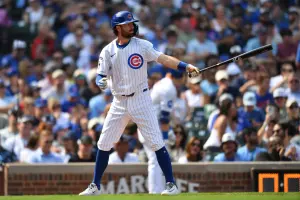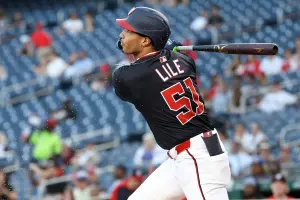
(*) NFBC: Using indicators to find weekly two-start pitchers
The strategy of streaming two-start pitchers (aka, two-steps) in weekly leagues is almost as old as fantasy baseball itself. Roto players will occasionally strike gold with waiver additions like Matt Shoemaker, Danny Duffy and James Paxton; pitchers who have the potential to be valuable assets for the remainder of the season. But more often than not, fringe free agent starters in 12 and 15-team leagues will disappoint and do harm to one’s ratio categories. For those behind in wins and strikeouts, there is nothing more tempting than bidding on two-steps with good-looking matchups on paper. Depending on league size, often our new free agent acquisition comes at the expense of a starting pitcher in our lineup who we may be dropping prematurely. Using BaseballHQ.com tools and indicators to separate the helpful from the helpless is imperative to making wise and confident two-step decisions.
In the hunt? Let BaseballHQ.com help you snag the title. Unlock all of our insights like these for the rest of the season: Subscribe to BaseballHQ.com.
As many of you are aware, the NFBC allows for mid-week roster moves with hitters, but the pitchers are locked in for the week on Mondays. Teams start nine pitchers, and can blend their ideal mix of starting pitchers, closers, and occasionally, dominant setup men. Most important to this discussion: teams carry only seven bench spots. That typically means owners have three to four bench pitchers on their roster at any time. Typically, one’s worst starting pitcher in this 12-team format is of decent value, for example, high-upside starters with bright futures like Kevin Gausman, Archie Bradley and Sean Manaea. A cold stretch of starts from our fringe guys can cause panic and the desire to drop them for a viable two-step, especially if one is chasing wins and strikeouts. Despite the desire for these stats, what this often becomes is a classic case of over-managing. As is the case on many Sunday nights when debating two-steps in our Sunday night FAAB, quite often no move is the right move. Patience in this case, is indeed, a virtue.
Using NFBC 12-team leagues (the Online Championship) as a baseline, let’s review the most useful pitcher metrics to help us identify fringe two-start starters who may or may not be worth our while in the right sets of matchups in a given week.
Left/Right splits
Without question, home-road and lefty-righty splits are the first group of stats to be familiar with when analyzing any type of pitching matchups. For the veteran fantasy player, common sense and intuition strikes us almost immediately. Unless our team has a nice cushion in ERA and WHIP, yet is desperately in need of W and K, we are not going to add Iván Nova for a road two-step against powerhouse Red Sox and Orioles offenses. On the flip side, we might want to consider Rangers’ southpaw Martín Pérez and his sub .500 oOPS against lefties in a week where he faces lefty-heavy lineups of the Yankees and Mariners. Though pitchers in hitter friendly ballparks like those in Colorado, Baltimore and Arizona tend to have stronger road splits, the majority of starting pitchers perform better in the familiar surroundings of their home ballpark.
Beyond these two commonly reviewed splits, there are over a dozen indicators we can use to help us to identify worthwhile waiver wire two-start pitching options in an upcoming fantasy week. The two best indicators to rely upon are Dominance rate or Dom (strikeouts per nine innings) and Control rate or Ctl (walks per nine innings).
Dominance
Dom is fairly straightforward for analysis’ sake. A fantasy squad falling short in their league’s strikeout category should target starting pitchers with high Dom, preferably those with a Dom greater than 7.5. Surely, a high-Dom starting pitcher available on your 12-team waiver wire is usually untouched for good reason. They typically have issues with their control, pitch for teams with poor run support, or are unpredictable from start to start.
Here are the starting pitchers with the best and worst Dom (strikeouts-per-nine) who are available in at least 15 percent of NFBC Online Championship leagues:
Best Dom Worst Dom
============================= ===========================
Robbie Ray (ARI) – 10.5 Justin Nicolino (MIA) – 4.2
Cody Reed (CIN) – 9.9 Jeff Locke (PIT) – 4.7
Nick Tropeano (LAA) – 8.2 Jered Weaver (LAA) – 5.1
Ubaldo Jiménez (BAL) – 8.1 Derek Holland (TEX) – 5.3
Jeremy Hellickson (PHI) – 8.1 Mike Leake (STL) – 5.8Ray is the most popular of the group, owned in right around 85 percent of NFBC 12-teamers. His home park does him no favors (5.90 ERA home, 3.50 road) and he carries a below league average WHIP (1.55) into the All-Star break. But Ray has seen a slight velocity increase on his fastball from 2014 and his SwK rate has risen from nine percent to 11 percent since last season. What’s of most importance is that Ray is incredibly consistent if you review his PQS logs—an uneventful PQS-2 or an average PQS-3 in 11 of his 17 starts and just a 16 percent DISaster rate. He is usually always worth an addition to your roster on a two-step week if both games are away from Chase Field.
Cody Reed has a bright future, but his first four big league games have been rough as he allowed 20 earned runs in 20 innings, while striking out 22. If he settles down and remains in the rotation, he could be a viable two-step option in the right matchups in July or August. Same with Tropeano, who has recently returned from a disabled list stint. Among the Dom leaders is Orioles’ veteran Jimenez, usually an easy pitcher to avoid, no matter the matchup. Jimenez’s ratios (6.95 ERA, 1.92 WHIP) are among the worst of all qualified major league starters and he has posted just one score higher than PQS-3 in 16 outings.
Among the list of pitchers readily available with the lowest Doms, there is one common theme—all but Holland have an average fastball velocity less than 92 mph. You can even add Kyle Gibson (6.0 Dom) and Iván Nova (6.1 Dom) to the group. Then, of course, there is Weaver and his 82.6 mph fastball. Groundball pitchers with lower velocity tend to have better control, in turn leading to respectable WHIPs, but almost everyone in this group has a WHIP north of 1.40 and have had their fair share of DIS starts. It’s simply a rough combination for those looking for two-step gems among this group. It puts the fantasy player in a position to both get thwarted in the ratio categories and with only a few strikeouts to show for it. Derek Holland is the most interesting of the bunch. He has a wicked 93 mph sinker and has posted higher Doms in past seasons, but has been pitching hurt this season. He is shut down until after the All-Star break, but is a name to keep in the back pocket down the stretch should he appear to be fully healed from those shoulder woes.
Control
Here are the starting pitchers with the best and worst Ctl (walks-per-nine) who are available in at least 15 percent of NFBC Online Championship leagues:
Best Ctl Worst Ctl
============================ ===============================
Mike Leake (STL) – 1.6 Ubaldo Jiménez (BAL) – 5.3
Tyler Duffey (MIN) – 1.7 Christian Friedrich (SD) – 5.0
Michael Fiers (HOU) – 1.9 Tom Koehler (MIA) – 4.7
Ricky Nolasco (MIN) – 1.9 Shelby Miller (ARI) – 4.6
Mike Foltynewicz (ATL) – 2.5 James Shields (CHW) – 4.1There is Leake again, but this time popping up on the asset side of the ledger. Leake’s respectable 1.22 WHIP is driven by his extremely low Ctl. As mentioned earlier, his Dom is low but he does not have a strong home vs. road split, making it more difficult to predict his good outings. Since he is owned in approximately 85 percent of NFBC 12-teamers, we can assume that if he is available in our league and the matchups on paper appear decent, he will receive double-digit FAAB bids. Fiers would likely be in the same boat when a two-step week arises, especially playing for a team that offers decent run support on most nights. Both Twins starters are interesting on two-step weeks when pitching at home. Ideally, we are looking to avoid starts in parks like Fenway and Rogers Centre.
On the flip side, let’s first point out that Francisco Liriano (PIT) leads all pitchers who have thrown more than 50 innings with a despicable 5.6 Ctl. Liriano has always had issues with control, but has posted valuable fantasy seasons over the last couple of years. Owners have grown tiresome of his act as they have begun dropping him in the NFBC Online Championship.
There’s Jimenez again. He actually earned a spot on 12-team rosters last season, particularly because of his performance in the first half of 2015 (2.81 ERA), but has regressed all the way to the bottom of the league. Koehler is an extreme flyball pitcher who calls a decent pitcher’s park home in Marlins Park where his ERA is nearly a full run lower. But Koehler is known for giving up too many walks and has only had two outings with a higher score than a PQS-3. Finally, we’ve got Shields, who has been one of the league’s most hittable starting pitchers since heading back to the American League, in his first stint with the White Sox. Shields is on pace for career-worst rates in Ctl and HR/9, the latter of which is especially scary since he led the league in homeruns allowed last season.
Home Runs
Home runs allowed per nine innings (HR/9) is another indicator to pay attention to. It assists in our awareness on pitchers like Josh Tomlin (1.8 HR/9) whose year-to-date stats might be deceptive. Similar to Héctor Santiago last season who saw a massive decline in fantasy production after the All-Star break—a 2.33 ERA prior and 5.47 after. On the surface, Tomlin’s 3.21 ERA and 1.09 WHIP have been more than helpful, but the high home run rate forces us to take caution. An indicator like HR/9 also keeps us far away from Chris Young, whose 3.4 HR/9 is three times the rate of the average starting pitcher. Interestingly, Jered Weaver pops up among the HR/9 leaders with his 1.9 rate, officially giving him a third strike and a reason to completely avoid him even in a two-start week.
The list of indicators worth monitoring is vast. Others deserving of our attention include expected earned run average (xERA) where we are looking for extreme variances in between a pitcher’s ERA and xERA to project improvement and regression towards their ERA. Swinging strike rate (SwK) and first pitch strike rate (FpK) are helpful tools in relation to strikeout rate and dominance for teams in need of strikeouts. That’s the beauty of the BHQ tools at our disposal. Those who make the time to dig into the array of indicators can add and avoid two-start pitchers in the NFBC with confidence.









